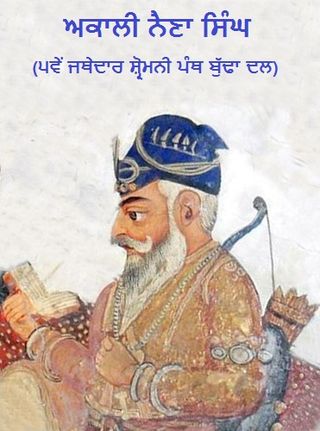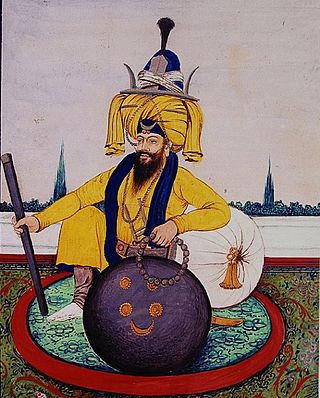Adherents of Sikhism follow a number of prohibitions. As with any followers of any faith or group, adherence varies by each individual.

Panth Rattan Shiri Gurcharan Singh Tohra was a president of Shiromani Gurdwara Parbandhak Committee (SGPC), a Sikh body in charge of controlling Gurdwara. He died of a heart attack in New Delhi on 1 April 2004 at the age of 79. He remained the head of the SGPC for a record 27 years, and was one of the most influential and controversial Sikh leaders of the 20th century.

The Nihang or Akali, also known as Dal Khalsa, is an armed Sikh warrior order originating in the Indian subcontinent. Nihangs are believed to have originated either from Fateh Singh and the attire he wore or from the "Akal Sena" started by Guru Hargobind. Early Sikh military history was dominated by the Nihang, known for their victories where they were heavily outnumbered. Traditionally known for their bravery and ruthlessness in the battlefield, the Nihang once formed the irregular guerrilla squads of the armed forces of the Sikh Empire, the Sikh Khalsa Army.

The Sarbloh Granth or Sarabloh Granth, also called Manglacharan Puran or Sri Manglacharan Ji, is a voluminous scripture, composed of more than 6,500 poetic stanzas. It is traditionally attributed as being the work of Guru Gobind Singh, the tenth Sikh guru. Scholars, on the other hand, attribute the work to after the Guru's death, being authored by an unknown poet. The work is mostly revered by the Nihang sect.

Majha is a region located in the central parts of the historical Punjab region, presently split between the republics of Pakistan and India. It extends north from the right banks of the river Beas, and reaches as far north as left bank of the river Ravi, constituting upper half of the Bari Doab.

Fateh Singh, commonly referred to with honorifics as Baba Fateh Singh or Sahibzada Baba Fateh Singh, was the fourth and youngest son of Guru Gobind Singh.
Guru Nanak founded the Sikh religion in the Punjab region of the northern part of the Indian subcontinent in the 15th century and opposed many traditional practices like fasting, Upanayana, idolatry, caste system, ascetism, azan, economic materialism, and gender discrimination.

The Sikh Khalsa Army, also known as Khalsaji or simply Sikh Army, was the military force of the Sikh Empire. With its roots in the Khalsa founded by Guru Gobind Singh, the army was later modernised on Franco-British principles by Maharaja Ranjit Singh. It was divided in three wings: the Fauj-i-Khas (elites), Fauj-i-Ain and Fauj-i-Be Qawaid (irregulars). Due to the lifelong efforts of the Maharaja and his European officers, it gradually became a prominent fighting force of Asia. Ranjit Singh changed and improved the training and organisation of his army. He reorganized responsibility and set performance standards in logistical efficiency in troop deployment, manoeuvre, and marksmanship. He reformed the staffing to emphasize steady fire over cavalry and guerrilla warfare, improved the equipment and methods of war. The military system of Ranjit Singh combined the best of both old and new ideas. He strengthened the infantry and the artillery. He paid the members of the standing army from treasury, instead of the Mughal method of paying an army with local feudal levies.

Akali Phula Singh Nihang was an Akali Nihang Sikh leader. He was a saint soldier of the Khalsa Shaheedan Misl and head of the Budha Dal in the early 19th century. He was also a senior general in the Sikh Khalsa Army and commander of the irregular Nihang of the army. He played a role in uniting Sikh misls in Amritsar. He was not afraid of the British who at many times ordered for his arrest but were not successful. During his later years he served for the Sikh Empire as a direct adviser to Maharaja Ranjit Singh. He remained an army general in many famous Sikh battles up until his martyrdom in the battle of Nowshera. He was admired by the local people and had a great influence over the land and his settlement was always open to help the poor and helpless. He was well known and was a humble unique leader and prestigious warrior with high character. He was also known for his effort to maintain the values of Gurmat and the Khalsa panth.
A takht, or taḵẖat, literally means a throne or seat of authority and is a spiritual and temporal centre of Sikhism. There are five takhts, which are five gurudwaras that have a very special significance for the Sikh community. Three are located in Punjab whilst the remaining two are located outside of it.

Baba Hanuman Singh, also known as Akali Hanuman Singh or Amar Shaheed Baba Hanuman Singh, was a Nihang Sikh and was the 7th Jathedar of Budha Dal and Jathedar of Akal Takhat. He was the successor of Akali Phula Singh. He was the first one who fought against the British. He attained martyrdom during a battle with the British and Patiala State in 1846.

Jathedar Baba Chet Singh (1914–1968) was a Nihang and was 12th Jathedar of Budha Dal after Baba Sahib Ji Kaladhari. He was born in 1914 at Talwandi. His father's name was Gurdit Singh and mother was Pradhan Kaur. He was succeeded by Jathedar Santa Singh Nihang. He died in 1968 at the age of 54. His memorial is located at Damdama Sahib. Among his famous saying was Fateh Singh Ke Jathe Singh, which he use for Nihang Army.

Naina Singh, also known as Narayan Singh, was a Nihang warrior and fifth Jathedar of Budha Dal and a chief of the Shaheedan Misl during the late 18th century.

Baba Darbara Singh, also known as Diwan Darbara Singh, was second Jathedar of Budha Dal and third leader of the Akal Takht. He should not be confused with other Darbara Singh of Sirhind who fought in the Battle of Anandpur.

Dharam Singh is a Nihang theologian, writer, preacher known for exegesis and expositions of Adi Granth and Dasam Granth. Enrolled as Nihang in Budha Dal, he worked as a secretary and participated in various religious conventions. He contributed the view of Sikh Religion on Human Rights in German Book, Menschenrechte im Weltkontext. In February 2015, he was the very first speaker of the dialogue series entitled Religion Matters established by the German Federal Ministry of Economic Cooperation and Development (BMZ). On letter call from SGPC, he had written various articles in response to Gurbaksh Singh Kala Afghana, who spoke against Amrit and Dasam Granth.

Pashaura Singh (1928–2008) also known as Santa Singh or to Nihang Sikhs as Jathedar Akali Baba Santa Singh Ji Nihang 96 Crori was the 13th Jathedar of Budha Dal, succeeding Akali Chet Singh.

The Jathedar of the Akal Takht is the head of the Akal Takht and head of the Sikhs worldwide. The jathedar has the de facto power as the supreme spokesperson of the Khalsa to summon, trial and sentence any person who identifies as a Sikh from the Akal Takht.
Surjit Singh (1945–2014) or Jathedar Surjeet Singh Akali was a Nihang and the 14th Jathedar of Budha Dal, after Akali Santa Singh. He was born on June 7, 1945, in Murar, Amritsar.
Joginder Singh, or Baba Joginder Singh is a Nihang Singh and is the 15th Jathedar of Budha Dal after Akali Surjit Singh. He was born in Boparai Kalan, Ludhiana.

The Sarbat Khalsa of 1986 was one congregation of the Guru Khalsa Panth, including the Damdami Taksal, Akal Takht, Panthic Committee (Manochahal), Panthic Committee (Zaffarwal), Kharku Sikhs, Tarna Dal (Hariabelan), Tarna Dal, Bidhi Chand Dal and the Shiromani Budha Dal.















